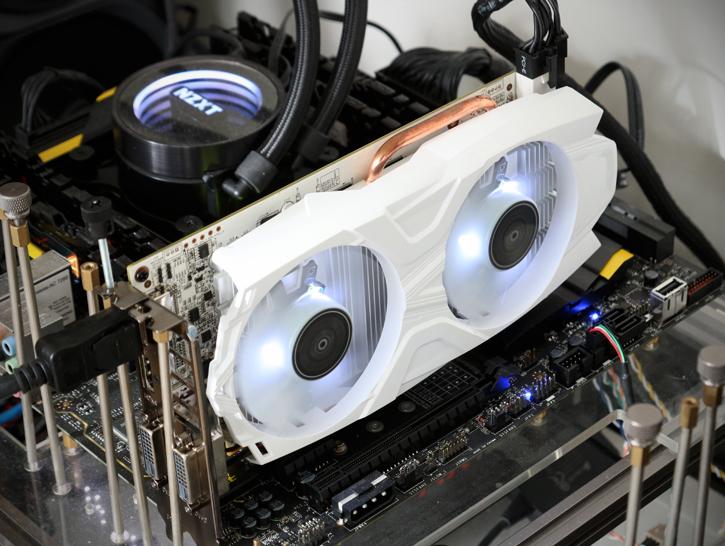Introduction
GALAX/KFA2 GeForce GTX 1050 Ti EXOC EDITION
That white factory tweaked GeForce 1050 Ti
In this article we'll review the bright GALAX/KFA2 GeForce GTX 1050 Ti EXOC, the graphics cards come in an all-white design, the two fans and cooling radiator make sure that this budget-minded cards never reach 60 Degrees C under load. We say budget minded as these cards are supposed to be very affordable and positioned in an attractive 139 dollar (US) segment. The reality is more difficult though, the product as tested today costs closer towards €199,- in the EU and $239 in the USA. The 1050 Ti series is Nvidia's answer to the Radeon RX 460 and 560, with the Ti models even flirting with the Radeon RX 570 from AMD. Both the GeForce GTX 1050 and Ti graphics cards are based on Pascal, fabbed with fins (FinFET) on an even smaller node, 14nm. As it turns out, the smaller fabrication process works out really well for Nvidia as they have been able to cram 3.3 Billion transistors into a very tiny 132 mm² chip. The GeForce GTX 1060, 1070 and 1080 have been a high-clocked success story ever since their launch. The new GeForce GTX 1050 and GeForce GTX 1050 Ti should suit gamers on a budget. Please note that there is no Founders Edition of the GTX 1050 (2GB) or 1050 Ti (4GB), you will only see board partner models. Based on a GP107 GPU the top model "Ti" SKUs will get 768 shader processors. The entry-level "regular" 1050 model will get 640 shader processors. By itself, it's nothing to dream about when you read the specs, but 14 nm has been treating Nvidia well, and as such you are going to notice fast clocked models and if you tweak a little, you should be able to reach that 2.0 GHz marker on the GPU Boost frequency.
| GTX 1060 6 GB | GTX 1060 3 GB | GTX 1050 Ti | GTX 1050 | GTX 950 | |
|---|---|---|---|---|---|
| GPU | GP106-400 | GP106-300 | GP107-400 | GP107-300 | GM206-250/251 |
| Shader processors | 1280 | 1152 | 768 | 640 | 768 |
| TMU's | 80 | 72 | 48 | 40 | 48 |
| ROP's | 48 | 48 | 32 | 32 | 32 |
| GPU freq | 1,506 MHz | 1,506 MHz | 1,290 MHz | 1,354 MHz | 1,024 MHz |
| Boost freq | 1,709 MHz | 1,709 MHz | 1,392 MHz | 1,455 MHz | 1,188 MHz |
| Mem freq | 2,002 MHz | 2,002 MHz | 1,752 MHz | 1,752 MHz | 1,653 MHz |
| Mem size | 6 GB GDDR5 | 3 GB GDDR5 | 4 GB GDDR5 | 2 GB GDDR5 | 2 GB GDDR5 |
| mem bus | 192-bit | 192-bit | 128-bit | 128-bit | 128-bit |
| TDP | 120W | 120W | 75W | 75W | 90W/75W |
With 640 shader processors, it means the GPU has five (1050 model) or six (768 shader processor for the 1050 Ti model) SMs active (six streaming multi-processors x (2x64) 128 shader cores). The cards will be equipped with 128-bit memory as well, in either a 2 GB or 4 GB model, though we strongly recommend the 4 GB models to be a bit more future proof. For the reference models that memory is tied to a 128-bit wide bus locked in at 1,752 MHz which is 7 GHz (GDDR5-effective) at a memory bandwidth of 112 GB/s. In this review, we are testing the GALAX (KFA2 in Europe) GeForce GTX 1050 Ti EXOC. This model is about trying to offer value for money, albeit that is difficult to explain these days with the inflated market prices. We'll talk about the precise specs on these puppies during the photo shoot, but the EXOC card comes with that white PCB, a dual-fan, and slot cooler and comes clocked at factory defaults of 1354 MHz as a base clock frequency, with a dynamic boost allowance of 1468 MHz. The GDDR% memory clocks in at 1752 MHz, which translates to an effective data-rate of 7008 GHz.

GALAX/KFA2 GeForce GTX 1050 Ti 4GB EXOC series with the Nvidia GP107-A1 GPU.

